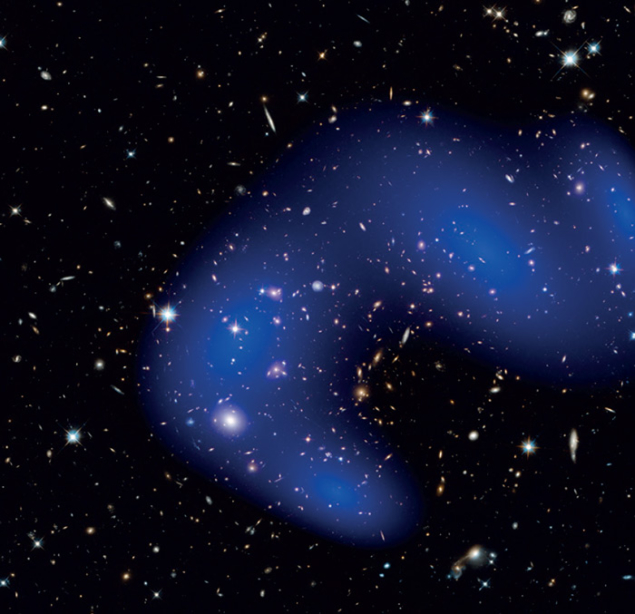
Image credit: NASA, ESA, D Harvey (EPFL), R Massey (Durham University), Harald Ebeling (University of Hawaii at Manoa) and Jean-Paul Kneib (LAM).
Astronomers using observations from the NASA/ESA Hubble Space Telescope and NASA’s Chandra X-ray Observatory have studied how dark matter in clusters of galaxies behaves when the clusters collide. The results confirm the distinct existence of dark matter with high significance, and show that dark matter interacts with itself even less than thought previously.
Although there is more dark matter than visible matter in the universe, dark matter remains extremely elusive and is, most likely, in a form outside of the Standard Model of particle physics. Dark matter does not reflect, absorb or emit light, making it transparent. The presence of a massive clump of dark matter can be probed only by its gravitational distortion of space–time, which bends the light path in its vicinity. This weak gravitational-lensing effect distorts the shape of background galaxies, making it possible to infer the spatial distribution of dark matter (CERN Courier January/February 2007 p11).
Collisions between clusters of galaxies provide a way to estimate the interaction of dark matter with itself. The “bullet cluster” is a prime example of such a collision, showing that while the hot gas is slowed down by ram pressure, the motion of both the dark matter and galaxies seems to be unaltered by the event (CERN Courier October 2006 p9). It constraints the self-interaction cross-section of dark matter by unit mass to σDM/m < 1.25 cm2/g (68% CL). To tighten this constraint further, a group of astronomers led by David Harvey – affiliated to both the École Polytechnique Fédérale de Lausanne (EPFL) and the University of Edinburgh – studied a sample of 72 mergers identified in 30 colliding systems, with archival observations by Hubble in the visible range and by Chandra in X-rays.
The team determined the central position of the hot gas glowing in X-rays, the galaxies and dark matter in each of the 72 collisions. The researchers assume that the direction of motion is given by the line connecting the location of the gas and of the galaxies, and then measure the position of the dark-matter component, both parallel and perpendicular to this direction. The latter serves as a check, and is found to be consistent with zero on average, as expected. Along the line of motion, the distribution of the offsets between dark matter and gas is found to be inconsistent (at 7.6σ) with the hypothesis that dark matter does not exist, i.e. that all of the cluster’s mass – except only about 3% in the form of stars in galaxies – is co-spatial with the hot gas. This rules out dark-matter alternatives such as modified Newtonian dynamics (MOND).
More interestingly, the ratio of dark matter and gas offsets from galaxies is a dimensionless measure of the drag force acting on dark matter. The authors of the study measured an average value of –0.04±0.07 (68% CL), which they translate to an upper limit of σDM/m < 0.47 cm2/g (95% CL) on the momentum transfer cross-section of dark matter. They note that this result rules out parts of the hidden-sector dark-matter models that predict σDM/m = 1 barn/GeV = 0.6 cm2/g, which is similar to nuclear cross-sections in the Standard Model. Such a high coupling in the dark sector would not have been in conflict with the orders-of-magnitude lower coupling between dark matter and Standard Model particles, which is at most in the order of picobarns.







